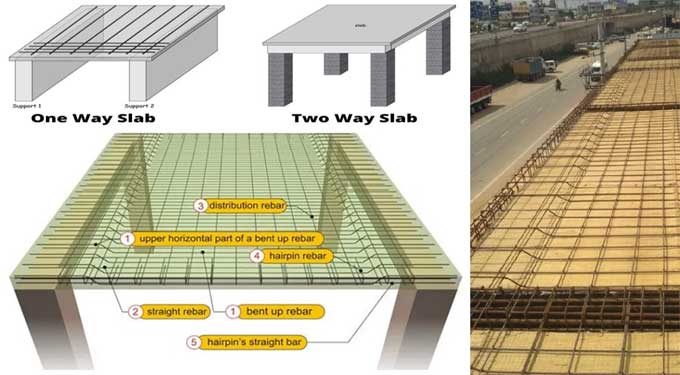
Bending Behaviour of One Way Slab and Two Way Slab
Bending is a process that, in essence, shows us what happens to an abundant structure when it is subjected to a heavy external pressure applied when it is at right angles to the baseline of an axis of the structure when the external pressure is applied for being at right angles to the longitudinal axis of that structure.
In most cases, the bending of slabs is caused by the distortion of the slab, which is caused mainly by the bend of the edges, causing the slab to bend upwards or downwards.
Slabs
Building slabs are horizontal structures that are used in the construction department of a building, which is used to construct floors, walls, ceilings, roofs, decks, and any other type of horizontal structure that is used in the building process.
In general, the slabs of this type have a thickness of some kind, and the beams that hold the slabs together are often reinforced and supported by concrete beams that reinforce the slabs.
One-way Slab
A one-way slab is a type of slab, which is supported by a parallel beam or wall, so it can be viewed as a two-dimensional structure. There is a large width and shallow depth of this beam, making it an excellent shallow beam.
In terms of slabs, a slab is a one-way slab when it is supported on both edges and bends in only one direction. A slab is also considered a one-way slab when it is supported on both edges and bends in only one direction. As the name suggests, one-way slabs have thicknesses corresponding to other dimensions of the slab.
As long as the slabs are restrained in some way or are possibly unrestrained, they can be considered one-way slabs. On the two opposite sides of the one-way slab, a beam supports the slab only on the two opposite sides.
Loads in a one-way slab are carried in one direction recumbent to the supporting beam. A one-way slab has a lower quantity of steel than other slabs, and the main reinforcement is the banding of the materials of the slabs.
Two-way Slab
It is known that a two-way slab is characterized by the fact that it is supported on four edges and bends in two directions at the same time. When the ratio of the slab's length to its breadth (L/B) is less than two, then the slab is considered and designed as a two-way slab because it is easy to move in both directions.
A two-way slab is one that can carry loads in both directions, as the load is to be carried in both directions. For two-way slabs, the main reinforcement is arranged in both directions in both directions of the slab.
Difference between One-way Slab and Two-way Slab
There are some significant differences between one-way and two-way slabs, regardless of what type of construction they are used for. In general, they consist of the following:
- One-way slabs are supported by beams on the two opposite sides, while two-way slabs are supported by beams on all four sides.
- A one-way slab supports the beam or walls from two opposite sides, while a two-way slab supports the beam or walls from all four sides.
- A one-way slab appears deflected and cylindrical, whereas a two-way slab appears more saucer-shaped.
- One-way slabs have a smaller amount of steel, while two-way slabs have more steel than one-way slabs.
- During the transfer of any load, the bend in a one-way slab is stretched over in only one direction, while in a two-way slab, the bend occurs on both sides and is stretched over in both directions.
- One-way slabs typically have a deflection of 100mm to 150mm, while two-way slabs have a range of 100mm to 200mm depending on their use.
- One-way slabs are reinforced in only one direction while two-way slabs are reinforced in both directions.
To get more details, watch the following video tutorial.
Video Source: cwill structures
Conclusion
The bottom line is that both slabs are vital components of any work of construction, and learning about them and knowing the differences between them may contribute to the design and construction of a number of different structures.


